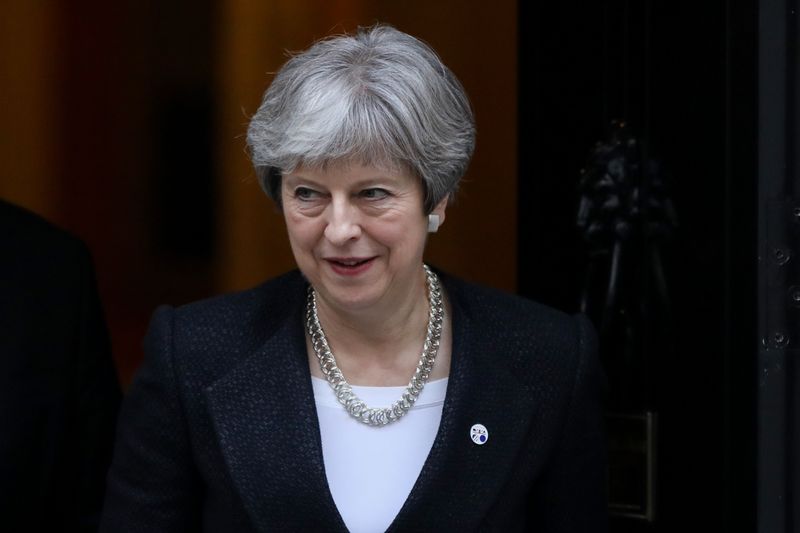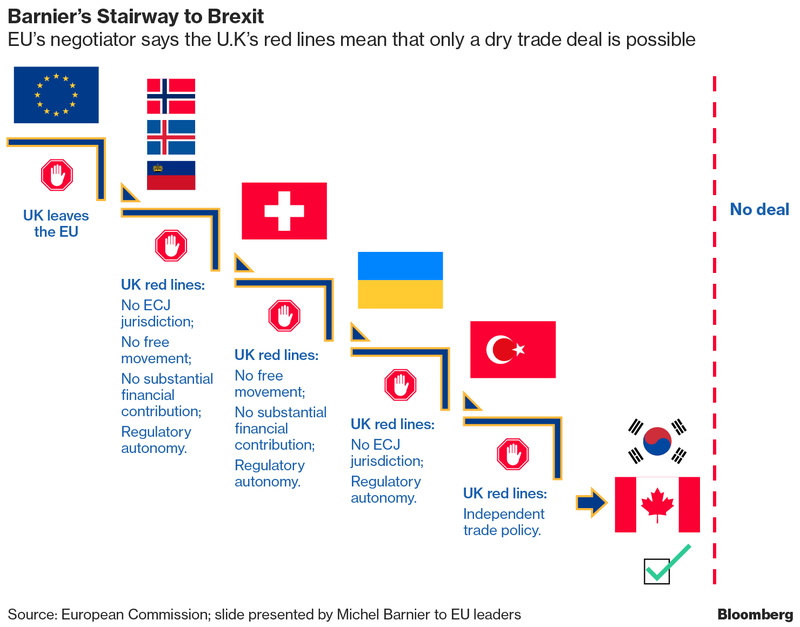
Theresa May, U.K. prime minister, leaves number 10 Downing Street following a meeting with Estonia’s Prime Minister Juri Ratas in London, U.K., on Tuesday, Jan. 30, 2018. Brexit campaigners in the U.K.’s governing Conservative Party would be “foolish” to try to overthrow May, Cabinet minister Liam Fox warned, as the prime minister battles critics on multiple fronts. Photographer: Luke MacGregor/Bloomberg
The hard choices of Brexit have tipped Theresa May’s Conservative Party into open warfare. It’s not clear the prime minister will survive the crossfire.
May has held onto her job by avoiding too much clarity on what Britain’s divorce from the European Union might look like, even as the process has been going on for nearly a year. She still hasn’t stamped her authority or a vision of Brexit on her divided Cabinet.
As she’s forced to reveal her hand, both extremes of her party’s Brexit spectrum are emboldened, with those seeking the most radical break from Brussels making threats, demanding firings, and questioning the integrity of the country’s revered civil service. They’ve even hatched a plot to oust her, according to the Sunday Times.
While the parliamentary arithmetic probably supports a divorce that maintains more ties to the European Union, and the anti-Brexit crowd is getting more organized, May knows she has to listen to the pro-Brexit hardliners. Her eagerness to keep them onside was underlined late Sunday when her office said the U.K. would leave the bloc’s customs union after the divorce, acceding to a key demand of the Brexit hardliners.
Jacob Rees-Mogg, a Conservative so keen on Brexit that he advocates leaving without even a transition period, has emerged as a potential leadership rival as critics of May are increasingly vocal. His unexpected popularity with Tory voters has pundits comparing him to Labour’s Jeremy Corbyn. At the very least, he’s a power broker supported by dozens of lawmakers.
At the heart of the conflict is how close a relationship Britain should seek with the EU after Brexit. Chancellor of the Exchequer Philip Hammond wants a “modest” separation, a view that has Brexit backers calling for his head.
The latest fight is whether the U.K. should remain in some kind of customs union with the EU after it leaves. Business says yes, as do some ministers and outspoken Conservative lawmakers. It’s an option that would help solve the intractable problem of what happens to the Irish border after Brexit. May has promised Ireland and the EU there will no hard border, and breaking that promise isn’t an option if she wants an orderly exit.
But the anti-EU camp see such a policy as a betrayal of their aims as it would neuter one of the key narratives of their campaign — that Britain should be able to strike trade deals around the world and recover its role as pioneering free-trading nation. Rees-Mogg has made his opposition clear, saying the lawmakers in his group wouldn’t support May if she pursues such a policy. Foreign Secretary Boris Johnson, the poster boy of Brexit and rival to May, is expected to make his opposition clear this week when ministers debate the issue.
May has said she’s open-minded on a customs union, but late Sunday a government official said she had ruled out staying in the EU’s current customs union and it’s not “government policy” to stay in “a” customs union either.
Barnier Wants Detail
Chief EU negotiator Michel Barnier will be in London on Monday and by Friday he’s expecting an “update” from the U.K. on what it wants the future relationship to look like. That will ratchet up pressure on ministers to decide on a common stance when they meet this week.
Home Secretary Amber Rudd, a Remain voter who’s also seen as a potential leader, said on Sunday the Cabinet was more united than it’s perceived over the shape of Brexit.
“I have a surprise for the Brexiteers, which is the committee that meets in order to help make these decisions, that’s meeting as you rightly say twice this week, is more united than they think,” she told the BBC. “I think that we will arrive at something which suits us all.”
Meanwhile, the anti-Brexit wing of the Conservative party is also looking emboldened as it fights to keep ties to Europe as close as possible, and realizes it probably has just six months to turn the tide.
A group of Conservative and Labour lawmakers produced an amendment last week that would force May to try to keep Britain in the customs union. It could win enough support, depending on the stance of the Labour Party, which is also being urged to abandon its ambiguity over the kind of Brexit it would seek in power.
In her interview with the BBC, it was the question Rudd didn’t answer that might prove the most insightful. She was asked: “Could you ever imagine serving under Boris Johnson?”
Her answer: “That is such a difficult question on so many different levels, I’m going to pass.”

